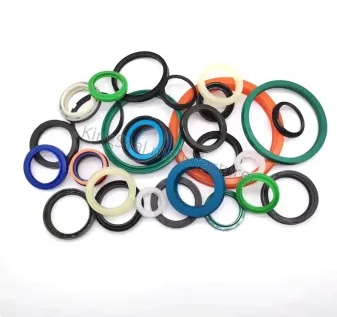Hydraulic Rubber Seal: Ensuring Efficiency and Reliability in Hydraulic Systems
Introduction to Hydraulic Rubber Seal
Hydraulic systems are widely used in various industries to transmit power and control machinery and equipment. A crucial component of these systems is the hydraulic rubber seal, which plays a vital role in preventing fluid leakage and maintaining the efficiency and reliability of the entire system.
Importance of Sealing in Hydraulic Systems
Sealing is an essential aspect of hydraulic systems, as it ensures that pressurized fluids remain contained within the system. A reliable seal prevents leaks, reduces downtime, and minimizes maintenance costs.
Types of Hydraulic Rubber Seals
1. O-Rings
O-rings are one of the most common types of hydraulic seals. Their circular shape allows them to fit into various grooves and provide effective sealing for both static and dynamic applications.
2. U-Cups
U-cups are U-shaped seals used primarily for reciprocating motion in hydraulic cylinders. They offer excellent sealing performance and are suitable for applications with limited space.
3. V-Rings
V-rings are used to protect rotary shafts from dust, dirt, and moisture. Their V-shaped profile ensures proper sealing even in challenging conditions.
4. Wiper Seals
Wiper seals, also known as scraper seals, prevent contaminants from entering the hydraulic system, ensuring the longevity of other seals and components.
5. Piston Seals
Piston seals are critical in hydraulic cylinders, providing a dynamic seal between the piston and cylinder bore. They maintain fluid pressure and prevent leaks.
6. Rod Seals
Rod seals are similar to piston seals but are designed to provide a seal between the rod and the cylinder head, ensuring smooth rod movement.
Materials Used in Hydraulic Rubber Seals
1. Nitrile Rubber (NBR)
Nitrile rubber is a common material used for hydraulic seals due to its excellent resistance to oil, water, and various fluids. It is cost-effective and widely available.
2. Fluoroelastomers (FKM)
Fluoroelastomers are highly durable and can withstand extreme temperatures and aggressive chemicals, making them suitable for demanding hydraulic applications.
3. Polyurethane (PU)
Polyurethane seals offer good abrasion resistance and flexibility, making them ideal for applications where high pressures and dynamic movements are present.
4. Ethylene Propylene Diene Monomer (EPDM)
EPDM seals are resistant to weathering and ozone, making them suitable for outdoor applications where exposure to environmental elements is a concern.
Factors Affecting Seal Performance
Various factors can impact the performance of hydraulic rubber seals:
1. Temperature
Extreme temperatures can affect seal materials, leading to hardening or softening, which may compromise the seal's effectiveness.
2. Pressure
High pressure can cause extrusion and nibbling of the seal material, leading to potential leaks and failure.
3. Fluid Compatibility
Compatibility between the seal material and the hydraulic fluid is critical to ensure long-lasting performance and prevent material degradation.
4. Surface Finish and Lubrication
Proper surface finish and lubrication are essential to reduce friction and wear on the seal, enhancing its longevity.
Installation and Maintenance of Hydraulic Seals
Proper installation and regular maintenance are essential for optimal seal performance:
1. Proper Seal Installation
Correct installation techniques, such as ensuring proper groove dimensions and avoiding sharp edges, are crucial for effective sealing.
2. Common Seal Installation Issues
Improper installation can lead to seal damage, leaks, and reduced equipment performance. Some common issues include twisting, overstretching, and incorrect groove dimensions.
3. Seal Inspection and Replacement
Regular inspection helps identify worn-out seals that need replacement, preventing potential leaks and system failure.
Advantages of Using Hydraulic Rubber Seals
1. Leakage Prevention
The primary function of hydraulic seals is to prevent fluid leakage, ensuring the system operates efficiently and safely.
2. Enhanced Equipment Performance
Effective sealing minimizes friction and ensures smooth operation, contributing to improved equipment performance.
3. Increased Efficiency and Cost Savings
Leakage prevention and optimized performance lead to reduced downtime and maintenance costs, resulting in overall cost savings.
Applications of Hydraulic Rubber Seals
Hydraulic rubber seals find application in various industries and equipment:
1. Hydraulic Cylinders
Seals play a crucial role in hydraulic cylinders, which are widely used in construction, manufacturing, and transportation equipment.
2. Pumps and Valves
Pumps and valves require reliable seals to maintain fluid pressure and control the flow effectively.
3. Mobile Hydraulics
In mobile equipment such as excavators and loaders, hydraulic seals ensure efficient operation under dynamic conditions.
4. Industrial Machinery
Hydraulic systems in industrial machinery rely on seals to maintain performance and prevent leaks.
Common Challenges and Solutions
1. Seal Extrusion and Nibbling
High-pressure environments can cause seal material to extrude into gaps or nibble away, leading to leaks. Selecting the appropriate seal material and design can mitigate these issues.
2. Seal Failure due to High Pressure
Seals must be chosen based on the system's maximum pressure to avoid failure under high-pressure conditions.
3. Compatibility Issues with Fluids
Selecting seals compatible with the hydraulic fluid prevents material degradation and maintains seal effectiveness.
Innovations in Hydraulic Seal Technology
1. Advanced Materials and Coatings
Research continues to develop new materials and coatings that enhance seal performance and extend their lifespan.
2. Smart Sealing Solutions
Incorporating smart technologies into seals allows for real-time monitoring of seal performance and early detection of potential issues.
Environmental Considerations
1. Sustainable Seal Materials
Manufacturers are exploring environmentally friendly materials for hydraulic seals to reduce their ecological impact.
2. Recycling and Disposal
Proper disposal and recycling methods for used hydraulic seals help reduce waste and environmental pollution.
Conclusion
Hydraulic rubber seals are vital components that ensure the efficiency and reliability of hydraulic systems. With the right material selection, proper installation, and regular maintenance, these seals prevent fluid leakage, enhance equipment performance, and contribute to cost savings. Innovations in seal technology and a growing focus on sustainability further improve their role in various industries.



